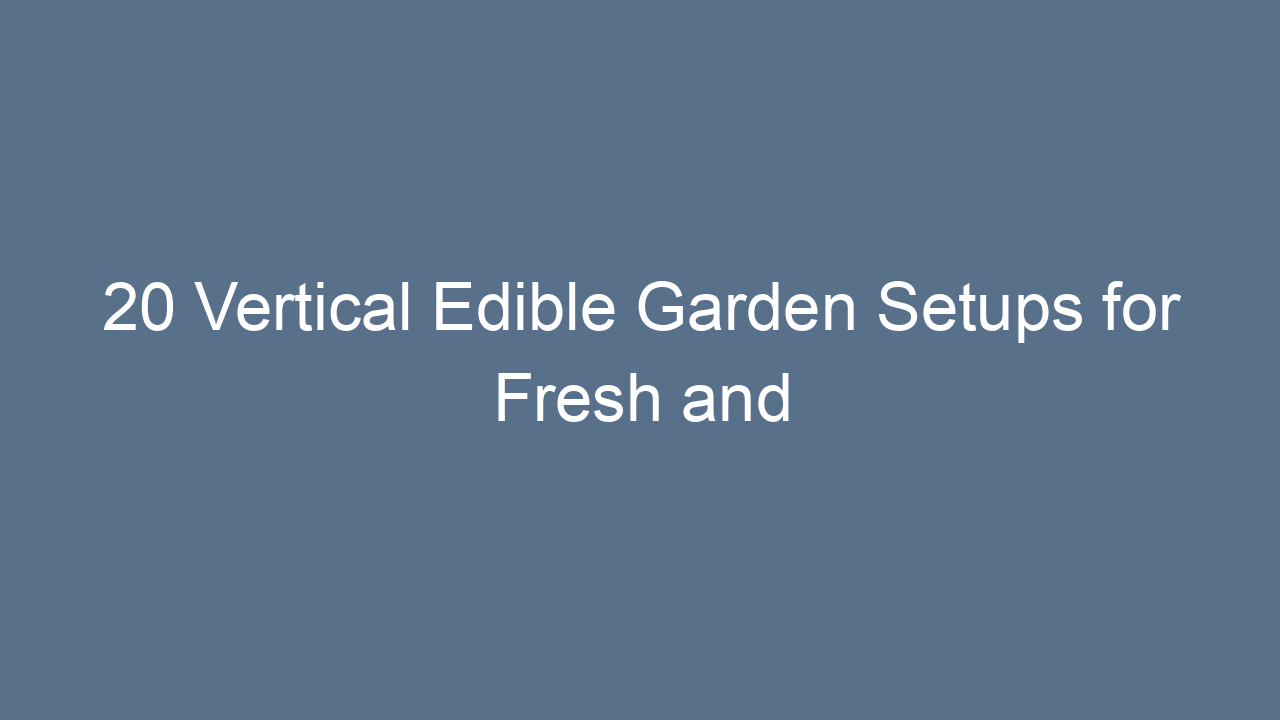20 Vertical Edible Garden Setups for Fresh and Flavorful Living

Creating a vertical edible garden is like turning a blank wall into a living pantry. It’s perfect for small spaces, urban balconies, or anyone who wants to grow fresh food without needing a big yard. Picture yourself plucking cherry tomatoes from a wall planter or clipping basil right next to your kitchen window. These setups don’t just save space—they bring beauty, fragrance, and flavor into your home. In this guide, I’ll walk you through 20 inspiring ideas, blending practicality with charm. Along the way, I’ll share personal insights, a few cultural touches, and tips you can use right away.
In This Article
- 1 1. Pallet Herb Wall for Small Balconies
- 2 2. Hanging Gutter Garden on a Fence
- 3 3. Ladder-Style Herb Stand
- 4 4. Towering Strawberry Planter
- 5 5. Mason Jar Herb Rack
- 6 6. Hanging Basket Veggie Garden
- 7 7. Vertical Hydroponic Tower
- 8 8. Shoe Organizer Garden
- 9 9. Trellis Wall for Climbing Veggies
- 10 10. Tiered Wooden Planter Boxes
- 11 11. Kitchen Window Shelf Garden
- 12 12. Wall-Mounted Pocket Planters
- 13 13. Bamboo Pole Garden
- 14 14. Spiral Vertical Garden
- 15 15. Repurposed Bookshelf Garden
- 16 16. Living Fence of Edible Vines
- 17 17. Hanging Coconut Shell Planters
- 18 18. Vertical Aquaponics Setup
- 19 19. Pergola Overhead Edible Canopy
- 20 20. Mixed-Style Wall Garden with Seasonal Swaps
1. Pallet Herb Wall for Small Balconies
A pallet herb wall is a budget-friendly way to start. Find an old wooden pallet, sand it down, and add small pots or landscape fabric to create planting pockets. Herbs like mint, cilantro, and parsley thrive here. The rustic wood brings a cozy, cottage vibe even to a city balcony. I once helped a friend in Dhaka create one, and we were amazed how it transformed her dull wall into a fragrant kitchen companion. The joy of snipping fresh herbs right before cooking adds a sense of pride that no supermarket bundle can match.
2. Hanging Gutter Garden on a Fence
Old rain gutters can become modern garden beds. Mount them on a fence or exterior wall in staggered rows. Fill them with leafy greens like spinach, lettuce, and arugula. This method works well for fast-growing plants that don’t need deep soil. A neighbor once joked that my fence looked like a salad bar on display—it was that lush and vibrant. It’s low-cost, visually striking, and easy to water since gravity helps moisture drip down.
3. Ladder-Style Herb Stand
If you’ve got an unused ladder lying around, transform it into a vertical edible garden. Lean the ladder against a wall, place wooden planks between the steps, and line up potted herbs or strawberries. It’s charming, movable, and perfect for renters. I love how it adds a casual, farmhouse look. Plus, you can adjust the spacing for plants with different sunlight needs.
4. Towering Strawberry Planter
A strawberry tower made from stacked planters or PVC pipes is a showstopper. You can drill holes along the sides for additional planting spots, turning a single vertical space into a berry wonderland. It’s delightful for kids—they’ll love spotting the red fruits peeking through the leaves. Fresh, sun-warmed strawberries taste worlds apart from store-bought ones.
5. Mason Jar Herb Rack
Mount a wooden board on your kitchen wall or balcony and attach mason jars with metal clamps. Fill them with soil and herbs like basil, thyme, and oregano. This setup is like functional wall art—your spices are literally growing on display. A friend visiting my apartment once said it looked like a “living spice rack,” and that stuck with me. It’s a conversation starter and keeps your herbs at arm’s reach while cooking.
6. Hanging Basket Veggie Garden
Use hanging baskets not just for flowers but also for cherry tomatoes, peppers, or even dwarf eggplants. Group three or four at different heights for a layered effect. The cascading greenery looks like a lush jungle, and the harvest is surprisingly generous. A breeze swaying the baskets adds movement and life to your garden corner.
7. Vertical Hydroponic Tower
If you’re tech-savvy or adventurous, try a hydroponic vertical tower. These systems circulate water and nutrients without soil, producing greens like lettuce and kale fast. I once tested a small kit on my balcony—it felt futuristic watching plants thrive in water streams. It’s ideal for those who want high yields and a modern touch.
8. Shoe Organizer Garden
A fabric shoe organizer hung on a door or wall can become a quirky edible garden. Fill each pocket with potting soil and small plants like spinach, radishes, or basil. It’s a fun way to upcycle household items while growing food. My cousin’s kids loved watering their “shoe salad,” which made them excited about vegetables.
9. Trellis Wall for Climbing Veggies
Beans, peas, and cucumbers adore vertical trellises. Install a wooden or metal trellis against a sunny wall, plant your seedlings at the base, and watch them climb. The greenery creates a natural curtain, offering privacy and shade. Last summer, my trellis cucumbers doubled as a sunblock for my patio seating—it was both practical and magical.
10. Tiered Wooden Planter Boxes
Stacking wooden boxes in a tiered formation creates a cascading edible garden. Each level can host different plants—herbs on top, strawberries in the middle, and leafy greens at the bottom. It’s visually appealing and efficient. Plus, it feels like you’re sculpting your own little hillside farm.
11. Kitchen Window Shelf Garden
Attach narrow shelves to your kitchen window frame to grow small pots of herbs or microgreens. Sunlight streams in, and the scent of basil or rosemary greets you every time you cook. This idea keeps your ingredients literally within reach while saving counter space. It’s cozy and perfect for apartment living.
12. Wall-Mounted Pocket Planters
Fabric or felt pocket planters are popular for a reason—they’re lightweight and easy to hang. Use them for lettuce, kale, or herbs. They create a soft, green tapestry that’s also functional. The first time I installed one, I couldn’t stop admiring how it turned a blank wall into a lush, edible mural.
13. Bamboo Pole Garden
Bundle bamboo poles together vertically and secure small planting containers between them. This setup blends well with natural, Zen-inspired décor. Bamboo’s earthy tone adds calm energy to patios or balconies. I remember sipping tea beside a friend’s bamboo pole garden—it felt like being in a serene forest retreat, even in the middle of the city.
14. Spiral Vertical Garden
A spiral garden, made by arranging stones or bricks in a winding tower, offers multiple microclimates. Plant sun-loving herbs at the top and moisture-loving greens at the bottom. It’s a sculptural piece and a clever way to maximize small spaces. Kids and guests often find themselves circling it out of curiosity—it’s that enchanting.
15. Repurposed Bookshelf Garden
Turn an old bookshelf into a vertical edible garden by lining the shelves with waterproof material and adding pots or planters. Bookshelves are sturdy and can hold a surprising amount of greenery. I once converted a thrifted shelf for my balcony, and it became the star of my garden photos.
16. Living Fence of Edible Vines
Transform a plain fence into a living wall by training edible vines like grape, passionfruit, or beans. Over time, the fence disappears behind lush foliage and edible rewards. There’s something poetic about a fence that feeds you instead of just marking boundaries.
17. Hanging Coconut Shell Planters
Half coconut shells make charming, eco-friendly planters. Hang them in clusters and fill them with herbs or cherry tomatoes. The natural texture pairs well with rustic or tropical décor. A friend in Chittagong used these on her porch, and they swung gently in the breeze like tiny green lanterns—absolutely magical.
18. Vertical Aquaponics Setup
Combine fishkeeping with gardening by using a vertical aquaponics system. The fish waste provides nutrients for plants, while the plants clean the water for the fish. It’s a closed-loop ecosystem that’s both fascinating and productive. Watching tilapia swim below while your lettuce grows above feels like nature’s own magic trick.
19. Pergola Overhead Edible Canopy
Grow climbing vegetables like gourds or beans on a pergola to create a shaded seating area beneath. As the vines grow, they form a natural canopy, offering beauty and comfort. Sitting under a leafy roof with dangling produce feels like stepping into a fairytale scene. It’s practical, too—gourds or beans are easy to harvest overhead.
20. Mixed-Style Wall Garden with Seasonal Swaps
Create a wall garden that mixes different planter types—baskets, pockets, and shelves. Rotate plants with the seasons: lettuce in spring, cherry tomatoes in summer, and herbs in winter. This approach keeps your garden dynamic and fresh all year. It’s like curating an art gallery that just happens to feed you.
Closing Thoughts
Building a vertical edible garden isn’t just about growing food—it’s about weaving nature into your daily life. Whether it’s a mason jar rack in your kitchen or a towering strawberry planter on your patio, each idea here offers a fresh way to connect with your food. These setups invite creativity and mindfulness, reminding us that even in small spaces, life can flourish vertically. Start small, experiment, and enjoy the taste of homegrown goodness—because there’s nothing more rewarding than a meal seasoned with your own harvest.






